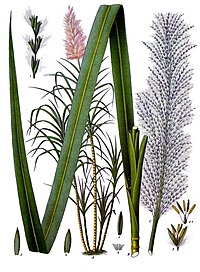
Photo from wikipedia
Sugarcane yellow leaf virus (SCYLV), the causal agent of yellow leaf, has been reported in an increasing number of sugarcane growing locations since its first report in the 1990s in… Click to show full abstract
Sugarcane yellow leaf virus (SCYLV), the causal agent of yellow leaf, has been reported in an increasing number of sugarcane growing locations since its first report in the 1990s in Brazil, Florida, and Hawaii. In this study, the genetic diversity of SCYLV was investigated using the genome coding sequence (5561-5612 nt) of 109 virus isolates from 19 geographical locations, including 65 new isolates from 16 geographical regions worldwide. These isolates were distributed in three major phylogenetic lineages (BRA, CUB, and REU), with the exception of one isolate from Guatemala. Twenty-two recombination events were identified among the 109 isolates of SCYLV, thus confirming that recombination was a significant driving force in the genetic diversity and evolution of this virus. No temporal signal was found in the genomic sequence data set, most likely because of the short temporal window of the 109 SCYLV isolates (1998-2020). Among 27 primers reported in the literature for the detection of the virus by RT-PCR, none matched 100% with all the 109 SCYLV sequences, suggesting that the use of some primer pairs may not result in the detection of all virus isolates. Primers YLS111/YLS462, which were the first primer pair used by numerous research organizations to detect the virus by RT-PCR, failed to detect isolates belonging to the CUB lineage. In contrast, primer pair ScYLVf1/ScYLVr1 efficiently detected isolates of all three lineages. Continuous pursuit of knowledge of SCYLV genetic variability is therefore critical for effective diagnosis of yellow leaf, especially in virus-infected and mainly asymptomatic sugarcane plants.
Journal Title: Plant disease
Year Published: 2023
Link to full text (if available)
Share on Social Media: Sign Up to like & get
recommendations!